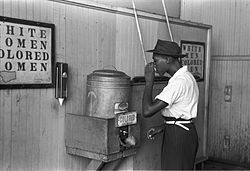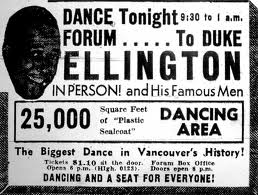No Integrated Checkers in Public: Revisiting Jim Crow*
Skip the B.S.
by Skip Eisiminger
“On the train . . . [the Negro’s place] is in front; on the ship it is below; on the streetcar it is in the rear; and in the theater it is above.”—Anonymous
“Jackie Robinson’s Dodger contract contained a clause saying he would not complain if spit on.”—Anonymous
CLEMSON South Carolina—(Weekly Hubris)—6/13/11—On a fine spring day, breezy but warm enough to remove windbreakers, my wife and I went to Independence Park in Charlotte NC for a picnic with our daughter and her family. After some Frisbee tossing and sandwiches, we lay back to watch the clouds scudding across the Carolina sky. At one end of the park, about 20 Latino boys were playing soccer. Beside us, an Anglo father was pitching wiffle balls to his small son as his Asian mother shagged the occasional fly ball. In the playground area behind us, some 50 children of all stripes were kicking their feet at the sky or sliding into the mud. Weaving in and out of the children was an interracial couple on in-line skates oblivious of the commotion.

I was tempted to call our nine-year-old grandson’s attention to the racial harmony, but I knew he took it for granted: his school had been fully integrated 30 years before he started kindergarten. I might as well have said, “Look, Spencer, the sky is blue!” To him, heaven had always been cloudless.
Back in 1906, however, the four-foot, chain-link fence separating the White from the Black waiting areas at one Charlotte railroad station wasn’t high enough, so the railroad raised it to the ceiling. Slowly though, fences started falling. In 1969, Charlotte officials ordered the removal of a six-foot-tall fence separating Blacks from Whites in a municipal cemetery.
To paraphrase Robert Frost, what was it their predecessors were fencing in or out?
I was fortunate that the military was integrated in 1948 so, as my family moved from post to post with my career-officer father, I often found myself beside African-American, Asian, and Hispanic peers in school, church, and gym. To the best of my knowledge, no harm in either direction was caused by these juxtapositions. During the upheaval wrought by civil rights legislation, I often wondered what all the turmoil was about. By the time I was old enough to take a biology course, I understood that we’re all Homo sapiens sapiens; 99.9999 percent alike, genetically speaking.
If we can donate blood, bone marrow, and organs to people of all races, and we can accept the same from them, the visible differences among us must be superficial indeed. Few things are more inconsequential when measuring human worth than skull dimensions, hair shapes in cross-section, melanin concentrations, and the width of noses, but those are some of the standards by which “science” once measured race.

Until we realize that all of us belong to the human race, it may help to remind ourselves just how far we’ve come:
Between 1880 and 1950, about 2,000 African Americans were lynched, often for the “crime” of displaying a higher concentration of melanin, an organic chemical that all humans except albinos have in their eyes, hair, and skin. In whatever concentration it is found, melanin protects the body from ultra-violet rays.
In 1946, the decorated World War II veteran, Sergeant Isaac Woodard, Jr. was blinded by the billy clubs of some racist police after using the “Whites Only” men’s room at a bus station outside of Augusta, Georgia, where no Black facility was provided.
- Many Southern states built separate universities, law,and medical schools to spare Whites the “indignity” of having to learn in the same room as Blacks.
- When the University of Oklahoma was integrated, the first Black students were assigned tables in the dining halls. To keep the races separated in the classroom, Blacks had to listen at the door.
- In the late 19th century, African Americans had to carry their vaccination documents when they left home. Whites moved about freely without such records.
- In West Memphis, Arkansas, the school board spent $144.57 per White student and $19.51 per Black in 1948.
- In 1947 in Clarendon County, South Carolina, some Black children had to walk nine miles one way to school as White children passed them in buses that Black taxes had helped to purchase. Before the state found transportation for these walkers, their parents pooled their savings and bought a used bus, refurbished it, drove it, and kept it filled with gas and oil. For the offense of signing a petition requesting a bus, every signer with a White employer lost his or her job, and many lost their homes.
- Many Southern courtrooms had separate Black jury boxes, witness stands, dockets, and Bibles. (The Bibles, though separate, were equal.)
- In Charleston, South Carolina, a Black nanny could stroll a White baby, whom she may have been nursing, through the city parks, but she could not sit on any of the benches. The law was relaxed on the Fourth of July, but few African Americans took advantage of the holiday largesse just blocks from where their ancestors had been sold.
- Jim Crow railroads sometimes carried African Americans and cattle in the same car.
- All-Black bands often played for all-White audiences in the 1940s, while Blacks listened at the windows. Light-skinned Blacks in Duke Ellington’s orchestra were obliged to darken their skin before going on stage lest the band appear integrated. B. B. King and his blues band played behind a sheet once (and only once) to spare the sensibilities of a White Louisiana audience.
- When Lena Horne’s daughter made the mistake of swimming in a Las Vegas pool reserved for Whites, the pool was drained. Many wondered what would have happened if the child had swum in the ocean.
- Shortly after World War II, German POWs in the United States were served in taverns and restaurants while the prisoners’ Black guards waited out of doors.
- Blacks were welcome to buy food at Southern restaurants; they just could not sit down to eat it. This led to Harry Golden’s famous“vertical integration” plan. Because standing “worked so well” in restaurants, Golden reasoned, the desks of all children should be removed from schools.
- African Americans were invited to buy clothes in White emporia, but they could not try them on. In some shoe stores, they had to present a cardboard cutout of their feet so the White clerk could “try the shoes on.” Clean socks were no excuse.
- In 1953, a White federal judge defended segregation as a “natural law,” adding that different species of birds do not perch on the same tree limb. Think hawk and sparrow.
Despite almost a century of ignorance and violence following the Emancipation Proclamation of 1863, there has been progress. When the former segregationist governor of Alabama, George Wallace, died in 1998, three of the eight pallbearers were Black. But as B.B. King observed, “Once we tasted the White man’s water, we realized it wasn’t any better than what we’d been drinking all along.”
*For those not familiar with Jim Crow: http://en.wikipedia.org/wiki/Jim_Crow_laws.
One Comment
diana
Good to be reminded. Thanks.